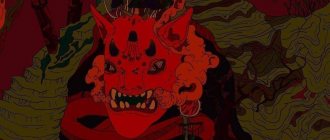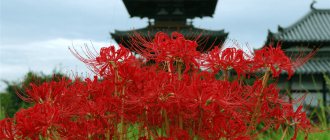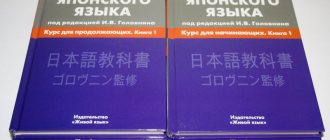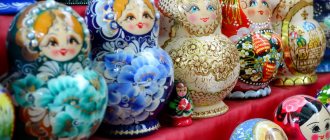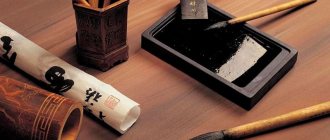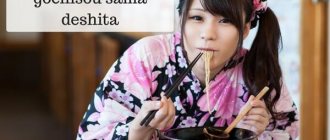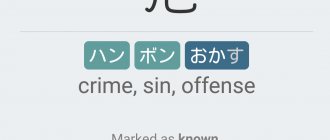We have heard and know a lot about the ancient Greek and Roman gods, about the Viking deities, but what do we know about the ancient Japanese gods? If we talk about the divine pantheon of the Japanese, it largely originates in the traditional mythology of Shintoism, the most ancient Japanese religion.
Japanese culture has influenced Buddhism and even Hinduism throughout history. The gods and goddesses of the Japanese were based on kami - mythical spirits and various mythical creatures. The Japanese described all this already in the 8th century, making a certain standardized template for the Shinto pantheon for almost all of Japan. Next you will get acquainted with some Japanese gods.
Original Japanese gods of the creation of the world
As in most folklore myths of different cultures about the creation of the world, Japan also had such creator gods. They are Izanagi and Izanami. This is a brother and sister duo. They brought order to the ocean of chaos under the sky. Izanagi and Izanami created the first continent. This was Onogoro Island. These gods were directed to this by even more ancient kami who lived in the sky. The divine brother and sister created the earth's firmament while standing on a ladder leading from heaven. They churned the ocean below them with a special precious spear until the island of Onogoro appeared. The brother and sister had deformed children.
One of them was the god Hiruko. The divine duo continued to create more and more islands. There were eight of them in total. They were inhabited by 800 spirits. When Izanami gave birth to Kagutsuchi, the god of fire, she could not bear the pain and died. After her death, she went to the underworld of Yomi. Her brother Izanagi went down there, but instead of his sister he saw a decomposing corpse. By this he angered the kami, who expelled him from Yomi. Returning to earth, Izanagi performed a cleansing ritual, which resulted in the appearance of a large number of other Japanese gods and goddesses.
Grim Reaper of the East
Before talking about the deity, it is worth mentioning one detail: the gods of death did not originally exist in Japanese folklore, they appeared there a little later. The word “Shinigami” consists of two components:
- “shi” means “death”;
- “kami” means “god” or “spirit”.
Although there have long been various types of kami (nature spirits) in Japanese mythology, shinigami only entered folklore in the 18th or 19th centuries. By the way, this word was not even used in classical Japanese literature. It first appeared in the Edo period to refer to theatrical performances that dealt with the spirits of the dead, spirits that captured the consciousness of the living, or double suicides committed by lovers.
God of luck and fishermen
Hiruko was the first child of the gods who created the earth. But he was born very ugly, since Izanagi and Izanami violated the marriage ritual. Hiruko is often called Yobisu. It brings good luck to fishermen. When Hiruko was born, he had no bones. When he was three years old, his mother threw him into the ocean, but the child survived. Ebisu Saburo helped him, so Hiruko began to call himself Yobisu. This god has always patronized children and fishermen.
It also brings good luck. Yobisu is also called the laughing god, he never loses heart. On his head he wears a pointed kazaori eboshi hat. Yobisu is the god of jellyfish because he has no bones.
Differences
It's worth noting that there are some important differences between Shinigami and Grim Reapers. According to Western belief, death is a being that represents the end of existence. In Japanese folklore, death is viewed not as a person, but as part of the natural life cycle, that is, a process. Shinigami are considered agents who help this cycle run smoothly.
The Grim Reaper takes lives and collects the souls of the dead, while Shinigami simply ensure that people die at their appointed time, and then their souls are escorted to the afterlife. They are considered more peaceful and friendly. And unlike the Grim Reaper, they don’t sneak up on you and forcefully drag you into the afterlife.
God of destructive fire
Kagutsuchi, the god of fire, was also the child of the divine couple. He burned his own mother with his fiery essence. His father Izanagi became angry. He could not bear the death of his wife and wife, so he cut off the head of the son who killed his mother. Blood flooded the earth and gave birth to even more spirits, among whom were the thunder gods, mountain gods and the dragon god. The Japanese considered Kagutsuchi the progenitor of many powerful gods who created iron and weapons. The god of fire was the destroyer of buildings, especially wooden ones. There are many religious rituals associated with it that pacify it.
How did the story end?
One day a man was called into a house to cure a sick person. When he enters, he sees Shinigami sitting at the patient's head, indicating that death is inevitable. The family begged to cure the patient and offered large sums of money. Overcome by greed, the man decides to take a risk, and when the Shinigami fell asleep, the doctor turned the bed so that when the kami woke up, he found himself at the feet of the patient. The patient's life was saved.
The wisdom of Odin's children: Viking sayings that are still relevant today
Tiramisu with matcha tea: makes you fall in love not only with its taste, but also with its beautiful design
The woman showed a beautiful dressing room, which turned out to be from a small pantry
The Shinigami was clearly unhappy with what the man had done, and when the man comes home, the kami criticizes him for his disobedience. But then he changed his tune and suggested that the man go out for a drink to celebrate his earnings. He liked the idea, and he follows the god of death. Shinigami leads him to a building with many candles burning. Kami shows the man his candle, which is almost burnt out because he did wrong to the patient. The God of Death offers a person to extend his life by transferring the wick and wax from his candle to someone else's. But the man fails, the remains of the candle fall out of his hands, and he dies.
Goddess of the Rising Sun
The Japanese call their goddess of the rising sun Amaterasu, or shining from heaven.
She is revered as the ruler of the kami kingdom, the High Heavenly Plain of Takama no Hara. She maintained the greatness, order and purity of the rising sun. Amaterasu is considered the ancestor of the imperial family.
She was born from Izanagi's left eye when he was cleansing himself of spirits.
In another myth, Amaterasu locked herself in a cave when a quarrel occurred between her and the storm god Susanoo.
Then the earth was covered in darkness. Only thanks to the jokes and persuasion of the other gods, Amaterasu left the cave, bringing with her sunlight. This goddess has always played an important role in Japan.
Many noble families claimed that their family descended from her.
Ghosts and demons
There are so many different demons and spirits in Japan that it is sometimes not easy to tell them apart. But we will try to figure it out.
Obake are spirits who, however, can have flesh and blood. But they change their images, playing the role of peculiar werewolves, most often animals. People were frightened by their screams and howls, which supposedly happened periodically at night and foreshadowed troubles.
If in European culture werewolves are most often
wolves , then in Japanese culture they are foxes and even cats.
But obake were not necessarily evil. It happened that they helped people, especially in gratitude when they protected them and their family members. Help often consisted of protection from evil spirits.
Separately, there are yokai - ghosts that do not look like ordinary people or animals, but strange entities, for example, one-eyed, long-necked. If we compare them with Russian mythology, they can be put on a par with, for example, goblin or water goblins.
Yokai
They live in certain places, but do not seek to meet the human race. For example, the Japanese merman is called Kappa.
Yokai can also be either evil or good. Most often they correspond to the fire element and the northeastern side. It is curious that in the cold season you almost never see them.
Another type of perfume is yurei. These are the restless souls of the departed, who can calmly wander the world of the living and take revenge on people. Most often they become one if the proper rites were not performed over the body during burial, or the person became a victim of violence, as a result of which he died, or he committed suicide.
Japanese Ghost Yurei
Yurei often live in non-residential buildings, temples, mountains, caves, and forests. Their skin color is red, black or blue, their faces are ugly and frightening, their arms dangle below, and instead of legs there is complete emptiness. Recently, yurei are depicted wearing the white kimono that the Japanese usually wear when burying people, and they have long black hair - hair is believed to grow even after death.
Most yurei are female, who once suffered greatly from love failures. The most famous yurei in Western culture is Sadako Yamamura, the girl from the well, known from the film “The Ring.”
There are also benshi spirits. They are able to transform into other creatures, which often deceive people: they make them fall in love with them or, conversely, inspire panic. An example of such a spirit is Norapothonn with a blue sphere instead of a head.
Belief in various spirits haunts the Japanese even now. Every year they hold Hyakki Yako - “the night parade of a hundred demons”, a kind of ghost festival. By the way, a frightening sight.
Moon God
Tsukuyomi, the Japanese moon god, is male. Tsuku means "month" and yomi means "reading". He was born from the right eye of Izanagi and, accordingly, he is the brother of Amaterasu. Tsukuyomi married his sister. Therefore, they united in one heaven. One day, Tsukuyome killed the goddess of food, Uke Mochi. After this terrible act, the relationship between Amaterasu and Tsukuyomi went wrong, and they began to appear in the sky at different times, never meeting each other again. This is how day and night appeared.
Cultural influence
At the same time, there was the influence of Western ideas, in particular Christian dogmas, which began to interact and mix with traditional Shinto, Buddhist and Taoist beliefs. For example, in Shinto and Japanese mythology, the goddess of death Izanami already existed. In Buddhism there was a demon Mrtyu-Mara, who incited people to death. As soon as Eastern culture met Western culture and the concept of the “grim reaper,” a completely new god of death appeared - Shinigami.
Who is not alien to rudeness, and who does not think about it: a funny rating of zodiac signs
The star of the film “Spy Kids” had a son: what the baby and his parents look like
Imagine the color black: an ophthalmologist told how to relieve eye tension
God of the seas and storms
Susanoo, god of seas and storms, another brother of Amaterasu. It came out of Izanagi's nose. His appearance was very disheveled, and his character was quarrelsome. Susanoo was constantly plagued by mood swings. This manifested itself in storms and bad weather. He was both benevolent and unkind. In Japan, located on the islands, there are many shrines dedicated to this god. Susanoo often fought and defeated the dragon. He cut off 10 heads of the monster and drank its blood. At the same time, he was also a negative god. He destroyed his sister's rice fields and even killed her servants.
Japanese death gods in pop culture
Today, Shinigami keep up with the times and can often be found in Japanese films, anime and manga. And in each of these works, the gods of death are assigned roles that are very different from the traditional ones. Apart from their association with death, modern Shinigami have little in common with their folklore counterparts.
As an example, consider the anime “Bleach”. Here, Shinigami mainly fight demonic entities, fight villains, and unravel various conspiracies. Moreover, one of the Shinigami is a person with strong spiritual power, which generally contradicts folklore canons. Little is said about the fact that the gods from this anime are guides of souls. If you read the manga of the same name, you can understand that this matter is dealt with by lower-ranking kami. And stronger Shinigami kill demons, protect the world from various threats and administer the work of ordinary gods.
What an appetite: feta cheese has become a scarce product due to bloggers’ love for it
Tatyana Dogeleva has stopped fighting old age and is trying on new roles
The couple celebrated their 73rd wedding anniversary by getting vaccinated against COVID-19
Weather Gods
Raijin and Fujin are gods of the natural elements. Raijin controlled lightning and brought down storms on mortals. He beat his drums with a giant hammer. Raijin is depicted with three fingers, symbolizing the past, present and future. Fujin is the master of the winds, which he carries in a bag over his shoulders. Fujin is the savior of Japan from the Mongol invasion, sending the divine kamikaze wind to them. You can often hear about him in myths about samurai. Fujin comes from the god of war, Hachiman.
"Black Butler"
Even if viewers think that this anime is about demons and deals with them (after all, this is exactly what it seems at first glance), they are mistaken. In this story, the Shinigami are the reapers. They take the souls of already dead people, but they can also kill a person on their own if he is in the way or is somehow objectionable. The highest ranking Reapers have a human appearance, the only difference being that they all have bright green eyes and wear glasses. By the way, it also says that a person who has committed suicide can also become a reaper. Every day he has to watch how people die, and only after atonement for their sins can the formerly human Shinigami find eternal peace.
These are just some examples of how modern man sees Shinigami. Some characters are completely different from those mentioned in the old legend. Perhaps one of the most striking examples is the vision of the god of death in the anime “Naruto”. Here the Shinigami is not a creature, but a seal - a shinobi technique called “Seal of the God of Death”.
As can be seen from the examples, Shinigami can look different, live among people or in their own worlds, but only one thing unites them. This is a connection with death.
Found a violation? Report content
God of War and Archery
Hachiman, the god of war, is between Buddhism and Shintoism. It evolved and became venerated in many Buddhist shrines. This happened at the end of the 9th century. As a Buddhist deity, Hachiman is revered as a bodhisattva. He is the guardian of shrines in Japan. This god is associated with war and culture. His avatars resided in Empress Jingu, who was at war with Korea, and her son, Emperor Ojin, around the 3rd century. He was the patron of the Minamoto clan in the 11th century. The Japanese also say about Hachiman that it was he who sent the divine kamikaze wind to the Mongolian fleet.
First story
One of the traditional tales tells the story of a man who is fed up with his life and prepares to commit suicide. But before he could do this, he was visited by Shinigami, who said that his time had not yet come. He also explains that every life is measured on a candle, and once the flame goes out, the person dies. This shows that Japanese kami do not decide who lives and who dies. To stop a person from committing suicide, Shinigami gives him advice on how to simply earn money.
The God of Death tells the man that he can pretend to be a doctor who can cure any disease. To do this, he needed to say a few magic words for the Shinigami following the person. Having heard them, the gods can return to the afterlife and prolong the life of the patient. But there was one trick: if a Shinigami sat at the head of a sick person, it means that he must certainly die, and no words will have any effect. Using this new knowledge, the man became very rich.
The “God of War” in the modern history of the Japanese army is called Nogi Maresuke. He was a man of difficult character, who was entrusted with the position of minister before the birth of Emperor Meiji, and he was also the mentor of the future Emperor Hirohito. Nogi Maresuke thoroughly studied Chinese writing and later began to faithfully serve the Japanese emperor. He was a supporter of external aggression and a policy of expansion and was known for his courage and willingness to sacrifice himself; he devoted himself to serving the emperor to the end, not sparing his life. For this he was nicknamed the “god of war.” Despite the fact that Nogi Maresuke participated in many battles, he cannot be called a talented commander: he only sent soldiers to certain death during attacks, without winning any victories during major battles. The most famous war in which he participated was the Russo-Japanese War (1904-1905). In this war, he barely managed to win one battle, but after it he asked permission to commit suicide. The Emperor of Japan did not want to lose “valuable personnel”, and therefore said to Nogi: “You can only commit suicide after my death.”
Nogi Maresuke was born on December 25, 1849, and from childhood he was raised in accordance with the principles of samurai morality "bushido", in the spirit of Confucianism, patriotism and loyalty to his state. In 1871, he graduated from military school, and then participated in the suppression of the Satsuma uprising, which was led by Saigo Takamori. In this battle, Nogi suffered a crushing defeat, during which he lost his entire army and even his flag - a symbol of the strength of his army. In this battle, Nogi lost his dignity, and later planned to commit suicide to prove his loyalty to his state. The top leadership of the armed forces from his entourage dissuaded him from this idea, and he turned to the emperor with a request for an amnesty, after which he abandoned the idea of suicide. For a long time he sought solace in wine.
In 1886 he went to Germany to study military science. He believed that the Germans lived an idle life and was greatly amazed when he saw that they were very reserved and approached any task responsibly and scrupulously. Returning to his homeland, he immediately wrote a “treatise on the reorganization of military service.” In accordance with this treatise, the Japanese army should have been reformed based on the orders of the German army. Military personnel were expected to consider it a sacred duty to obey orders and always wear a uniform that was always clean and tidy. In 1894, the Sino-Japanese War began. Nogi Maresuke commanded the 1st Infantry Brigade. By order of the commander of the first division, Shandi Yuanzhi, before the start of hostilities, Nogi wrote a poem about the high aspirations of the Japanese army. When his troops arrived in China, he captured the strategically important city of Liaodong, occupied a fort at Dalianwan Bay, and easily captured a large amount of Chinese military equipment. In excellent spirits, Nogi and his army continued to advance, but they were ambushed by the Qing army, which led to huge losses. The Japanese army destroyed the city of Lushun, after which, wanting to take out all his anger, Nogi ordered his soldiers to burn, kill and loot inside this city. As a result, 20 thousand Chinese civilians were killed.
In 1896, Nogi Maresuke was appointed as the third Governor-General of Taiwan. During his stay in Taiwan, his army was attacked by the local population. As a result, hundreds of Japanese soldiers died, and he returned to his homeland in disgrace. Already in Japan, wanting to hush up this matter as quickly as possible, Nogi said: “There is nothing to do in Taiwan, it is better to sell it to England or France.” After these words, representatives of the Japanese high command laughed loudly and called him a mediocre coward who could not cope with the “scum.”
Phoenix 04/25/2019 Sohu 11/24/2018 Asahi Shimbun 03/19/2013
In February 1904, Japan and Russia engaged in a fierce battle on the Liaodong Peninsula, where a bloody battle broke out for the main port of the Russian Pacific Fleet, Port Arthur. To win this battle, Nogi decided to make an interesting move, which he borrowed from ancient China: before the start of the battle, three coffins were carried out as a symbol of the Japanese army's determination to die for their emperor. Who knew that these coffins would really be needed, since due to the erroneous command of Nogi, his two sons died on the battlefield. Taking into account the experience of the Sino-Japanese War and the current Russian-Japanese won at that time, the General Staff of the Japanese Army doubted the possibility of capturing the fortress Port Arthur in one day. Nogi Maresuke not only confirmed these doubts, but also turned the battle into a bloodbath. In June 1904, the Japanese 3rd Army, 2 reserve regiments, 2 field artillery brigades - a total of 56 thousand people and 386 guns - began a full-scale 150-day siege of the Port Arthur fortress, where 33 thousand Russian soldiers were located. Panic reigned among the Japanese fighters, blood flowed like a river, mountains of corpses lay on the ground. Nogi took any measures, dug tunnels, made night forays, even organized a suicide squad of 3.5 thousand people with special white armbands. During this battle, 50 thousand Japanese soldiers died, including his second son. Ultimately, as a result of an attack by “live bullets” of the Japanese army (suicide soldiers - editor's note), Russia announced surrender, and Japan won the battle.
After the end of the Russo-Japanese War, Nogi Maresuke left the corpses of his soldiers and sons and returned to his homeland. On the way home, he composed a poem, which he later read at a gala banquet. It spoke of the heroic imperial army, which fulfilled its duty, and of itself being disgraced, not knowing how to look into the eyes of people, having lost its sons. At this ceremony, Nogi stated that he blames himself for all the deaths and cannot come to terms with such a great loss. The only way out that he saw for himself and which would allow him to atone for his sins was suicide. However, Emperor Meiji flatly refused to accept his will, saying: “You can only commit suicide after my death.” On July 30, 1912, Emperor Meiji died and Nogi served as an honor guard. After the death of the emperor, he decided that the opportunity had come, and together with his wife he committed suicide, going after the emperor.
Some experts consider Nogi's act radical, but those who share the ideas of Japanese militarism are convinced that this fact in history was of great importance for the future military structure of their country. They unanimously argue that this model of behavior of a person devoted to his state, together with a national funeral, the construction of a Shinto shrine in his honor and the erection of a statue made of reinforced plastic, lead to the deification of his personality. During the reigns of Japan's 123rd Emperor Taisho (Yoshihito) and the 124th Emperor Showa (Hirohito), he was respectfully called the "god of war."
InoSMI materials contain assessments exclusively of foreign media and do not reflect the position of the InoSMI editorial staff.
Promote this tweet
Kazuma (兆麻Kazuma) is the main shinki of Bishamon, analyzing the situation and coordinating the actions of his goddess. Takes the form of a flower-shaped stud earring, capable of tracking enemies and seeing the accumulation of negative energy.
Smokes. He loves his goddess very much, which is why Yukine and Hiyori decided at their first meeting that they were married. Yato answers the schoolgirl's prayer and ends up being rejected by Tomone's own sacred weapon.
Yato takes Hiyori and Yukine to the goddess of poverty, Kofuku. Yato teaches Yukine to draw the line and warns him about ghosts. Most Japanese myths are known through the Kojiki, Nihon Shoki, and some additional sources.
The mythology of Japan includes a large number of deities (this is enshrined in the saying “Japan is a country of eight million deities”). These five gods have a special place among the "Amatsukami" (天津神, "Heavenly Gods").
They had two children: Hiruko and Awashima, but they were ugly. Izanami and Izanagi repeated the wedding ceremony, and from then on the union became happy. Then she agrees to return to the world of the living, but first wants to rest for a while, so she retires to the bedchamber and asks her husband not to go there. Izanagi screamed in horror and fled from the underworld, blocking the entrance there with a stone.
